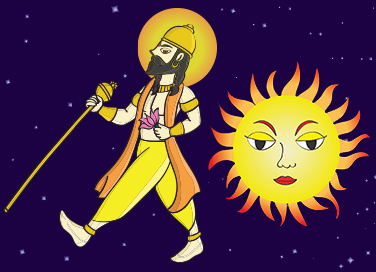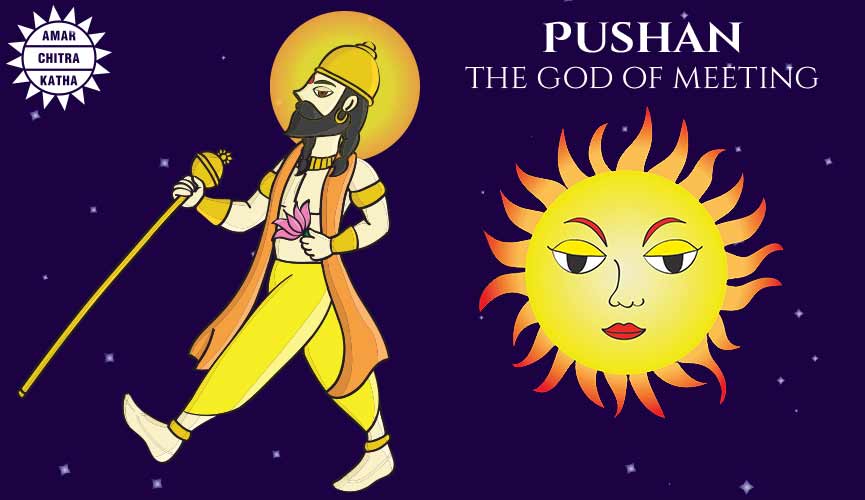The Sad Story of Pushan
- December 15, 2020


The Sad Story of Pushan
- December 15, 2020
By Shivam Pathania

Pushan is one of the twelve Adityas that reside in the heavens above with his parents, Sage Kashyap and Aditi. He wears his hair in braids, has a beard, and carries a golden sceptre. According to the Vishnu Purana, one of the Adityas would take the role of the sun every month and rule over the planets for that entire month. As per hymns in the Rig Veda, Pushan has a chariot pulled by rams, which can be interpreted as a symbolic way of representing the Mesh Rashi or Ram constellation preceding the Revati constellation that is ruled by Pushan. During the New Year, the two mentioned constellations appear just before sunrise, in the dim-lit winter sky in the northern hemisphere, and this astronomical event is creatively narrated through the symbolic story of Pushan’s chariot clearing the path for the sun god, Surya and his chariot pulled by the seven-headed horse, Uchchaihshravas.
Ancient Indians were pioneers in the realm of astronomy, and the abovementioned role of Pushan is a symbolic representation of the stars and constellations. This depiction of Pushan in the story can be further used to interpret the deity’s other duties. Pushan is considered the god of journeys and roads, and a protector of travellers. His golden sceptre is a symbol of his constant movement as the god of journeys. The same logic can be used to explain the deity’s role as a psychopomp, guiding departed souls on their journey to their afterlife. Pushan is also the god of meetings, a natural culmination of his status as god of journeys, because in order to have a successful meeting with someone, one must make a successful journey. He also plays the role of the god of nourishment, which is an aspect of the sun, as all living beings on earth rely on the sun for their survival, making Pushan the deity responsible for healthy crops, pasture and cattle.
To receive more such stories in your Inbox & WhatsApp, Please share your Email and Mobile number.
However, even after playing so many essential roles as a deity, the prominence of Pushan is replaced by more important gods with similar roles. Even among his siblings, the Adityas, there are those that are considered more important such as Surya and Indra. Surya is the sun god and the king of all planets, overshadowing Pushan’s role as the deity of nourishment, whereas Indra is the god of rain and lightning, and the king of gods, overshadowing Pushan’s role as the god of crops and pastures. Pushan also shares his role as a psychopomp with another major deity, Agni, the god of fire, who is crucial in all major Hindu rituals. The prominence of Pushan’s role as the god of journeys is also diminished as this duty is in some way similar to Ganesha’s. The elephant-headed god is known as Vighnaharta, which literally means ‘the one who removes obstacles’. Ganesha’s father, Shiva, the God of destruction and one of the Trimurti, is also called Pashupati where he is seen as the king of all animals, overshadowing Pushan’s duty as the god of cattle.
Shiva and his family have been a source of trouble for Pushan previously as well. After Shiva’s wife, Sati immolated herself, Shiva was wreaking havoc at Prajapati Daksha’s yagna in the form of Veerabhadra, when he ended up knocking out all of Pushan’s teeth. The poor god’s teeth were smashed with such brute force that the broken teeth flew to outer space and are said to have become the stars in the milky way! This is the reason why the god of meeting can only consume liquid food, and is given curd or mashed food as an offering.
To receive more such stories in your Inbox & WhatsApp, Please share your Email and Mobile number.

Comic of The Month
The Naval Journey of India Book I
This book is the first of a three-book series that takes a deep and detailed look at India's Naval History and a deep insight into the lives of our men and women in white. But any series on the Indian Navy has to start at the very beginning - exploring India's celebrated maritime history. Join our little hero, Bharat, and his grandfather, Commodore Sagar, as they sail into the deep blue waters of time. Book I of The Naval Journey of India takes a sweeping look at India's maritime endeavours, how the seas impacted us over millennia and how the oceans made us who we are.